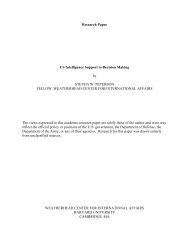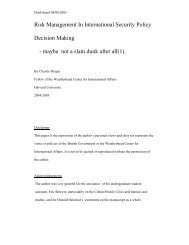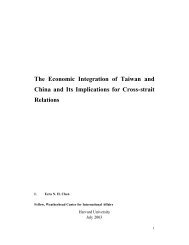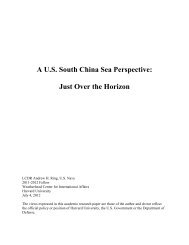A U.S. South China Sea Perspective: Just Over the Horizon
A U.S. South China Sea Perspective: Just Over the Horizon
A U.S. South China Sea Perspective: Just Over the Horizon
You also want an ePaper? Increase the reach of your titles
YUMPU automatically turns print PDFs into web optimized ePapers that Google loves.
Abstract<br />
In 2011 Secretary of State Hillary Clinton declared that <strong>the</strong> twenty-first century will be<br />
“America’s Pacific century.” 1 This pivot of U.S. foreign policy to concentrate on <strong>the</strong> Asia-<br />
Pacific region offers many opportunities, but <strong>the</strong> greatest challenge, and most likely flashpoint<br />
for military conflict in <strong>the</strong> region, is decades-long sovereignty disputes over <strong>South</strong> <strong>China</strong> <strong>Sea</strong><br />
islands.<br />
Six nations — <strong>China</strong>, Malaysia, Brunei, Philippines, Vietnam and Taiwan — have<br />
claimed sovereignty over several islands, reefs, and in many cases, large rocks, so as to gain oil<br />
and fishing rights. These claims threaten freedom of navigation and stability in <strong>the</strong> <strong>South</strong> <strong>China</strong><br />
<strong>Sea</strong>, which has become critical to <strong>the</strong> world economy due to <strong>the</strong> enormous volume of trade and<br />
petroleum that passes through its waters.<br />
<strong>China</strong>’s claim of sovereignty encompasses over 80% of <strong>the</strong> <strong>South</strong> <strong>China</strong> <strong>Sea</strong>, along with<br />
its growing political, economic and military strength, have prompted <strong>the</strong> o<strong>the</strong>r disputants to<br />
develop closer diplomatic and military ties with <strong>the</strong> United States. To protect American interests<br />
and balance <strong>China</strong>’s growing military capability, <strong>the</strong> U.S. Navy is increasing its presence in <strong>the</strong><br />
region and may establish new naval bases in Singapore, <strong>the</strong> Philippines, and even Vietnam.<br />
Before increasing U.S. naval presence in <strong>the</strong> <strong>South</strong> <strong>China</strong> <strong>Sea</strong>, <strong>the</strong> U.S. Navy should first<br />
endeavor to improve military-to-military relations with <strong>China</strong>. The U.S. Navy could facilitate <strong>the</strong><br />
inclusion of <strong>the</strong> Chinese military to participate in <strong>the</strong> hundreds of exercises conducted in <strong>the</strong><br />
Pacific every year, building trust ra<strong>the</strong>r than acting on mistrust. The Unites States and <strong>China</strong><br />
could also pursue various common goals in <strong>the</strong> region that could transform strategic threats into<br />
strategic cooperation. The current course of assertive U.S. policy and increased military presence<br />
must be reevaluated or it could create instability in <strong>the</strong> region and block <strong>the</strong> path to resolving <strong>the</strong><br />
<strong>South</strong> <strong>China</strong> <strong>Sea</strong>’s sovereignty disputes.<br />
4















